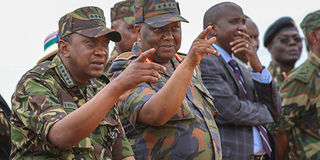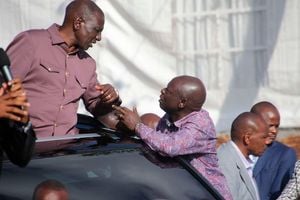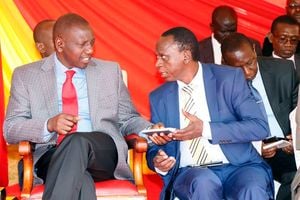The president and his uniform

President Uhuru Kenyatta and Chief of the Kenya Defence Forces (KDF) General Julius Karangi watch a demonstration by KDF soldiers at a training camp in Archer's Post, Isiolo County. FILE PHOTO | PSCU |
What you need to know:
- President Kenyatta is the third Kenyan president to be photographed in military uniform, after Jomo Kenyatta and Daniel arap Moi. Mwai Kibaki did not appear in public in military gear.
- In Germany, for instance, the C-in-C wears no uniform as the Constitution — or Basic Law of Germany — provides for a civilian Minister of Defence as overall commander.
- Field Marshals typically command large, multinational armies of up to a million soldiers, as happened during the Second World War.
Can you tell a Kenya Army Colonel from a Brigadier? Prior to the war in Somalia and the siege at Westgate, the question of what Kenyan soldiers wore and what it meant attracted little attention.
But Kenya is now at war, and a lot of people are keenly watching the mannerisms and straight-backed poises of the country’s Generals for clues on how we are faring on the battlefront.
That, and the fact that we now have a president who does not mind being seen in full military gear once in a while. In fact, it is that one last factor that heightened the public consciousness on the fatigues of the Kenya Defence Forces. There is something, it turns out, about a man in uniform.
It was the English novelist Charles Dickens, writing in Pickwick Papers, who said “a good uniform must work its way with the women”, but Uhuru Kenyatta’s military gear did not catch the attention of women only; it attracted the eyeballs of everyone.
NATIONAL PRIDE
Perhaps people viewed the President in military uniform as an emblem of national pride, a celebration of what George S Patton Jr — the US Army general best known for his flamboyant character and command of the Seventh United States Army in the European Theatre of World War II — called “a good soldier... (with) discipline, self-respect, pride in his unit and his country, a sense of duty and obligation to comrades and to his superiors, and a self-confidence born of demonstrated ability”.
Either way, the President got the nation talking. Photos of him looking like a commando were shared on social media hundreds of thousands of times. The Commander-in-Chief really oozed the charisma and energy of a commander.
Opinion was split between those who loved their President looking tough and those who were sceptical about how appropriate that was, and military spokesman Bogita Ongeri, speaking to DN2 later, clarified that it was necessary for the President to wear the uniform.
We had asked him who had chosen the attire for the President when he visited soldiers at a training camp at Archer’s Post on September 5 this year, and whether it really befit his status as Commander-in-Chief.
“He wore the proper uniform as Commander-in-Chief,” Mr Ongeri said. “Soldiers like to see and spend time with their commanders, particularly at this time when they are fighting Al-Shabaab in Somalia.”
HONOURABLE MEMBER
A few days later — on October 14, 2014 — President Kenyatta wore a Kenya Navy combat uniform at the Kenya Defence Forces Day celebrations in Lanet, Nakuru.
Mr Ongeri explained that a ceremonial military uniform provided an opportunity for the President to wear certain decorations that only he could rightfully don, such as the Chief of the Golden Heart of Kenya.
Major (rtd) Imaana Laibuta favours the President wearing a uniform, although he notes that elected leaders in developed countries tend to avoid it.
“It is appropriate for the Commander-in-Chief to wear the uniform since he is technically an honourable member of the armed forces,” he says.
President Kenyatta is the third Kenyan president to be photographed in military uniform, after Jomo Kenyatta and Daniel arap Moi. Mwai Kibaki did not appear in public in military gear.
In Kenya, the Commander-in-Chief has always worn military uniform, although only occasionally. In many countries, for a variety of reasons, this practice is not followed.
In Germany, for instance, the C-in-C wears no uniform as the Constitution — or Basic Law of Germany — provides for a civilian Minister of Defence as overall commander.
MILITARY UNIFORM
If the country enters a “state of defence” when its territorial integrity is threatened or violated, the Chancellor, also a civilian, assumes the role of Commander-in-Chief.
This arrangement works to diminish the military as a political force in a country that has suffered from a militarist past. Online pictures of Germany’s Commander-in-Chief visiting soldiers in Afghanistan show the minister wearing only protective clothing, and never a uniform.
In practice, senior military officers around the world who retire from the military and win presidential elections are reluctant to wear the uniform in office.
Most notably, Dwight Eisenhower, who served as a five-star general in the Second World War and was buried in military uniform, chose not to wear it during his two terms as president, out of respect for the civilian nature of the office.
The correct practice for Kenya, historical evidence suggests, is that the Commander-in-Chief should not only respect military tradition, but also make it unequivocally clear that the military answers to civilian authority.
The law on the same should also be consistent. Currently, the military status of the Commander-in-Chief is unclear, according to the Kenya Defence Forces Act 2012.
Section 28 (1) allows for state officers who are not recruited to become members of the defence forces.
MILITARY RANK, MILITARY COMMAND
If the effect of this clause is to make the President a member of the Kenya Defence Forces, then Section 46 (1) (a) makes it impossible for the President to campaign for any policy or cause, or even his own re-election.
Interestingly, the 2010 Constitution does not outline and enshrine civilian control of the military in the same way that it did the separation of powers, protection from abuses such as detention without trial, and gender equality.
This is probably because the military, which earned a reputation for professionalism after the abortive coup of 1982, was not the foremost target of political agitation during the 1990s.
In addition to the appropriateness of military uniform for an elected commander-in-chief, the question of what constitutes appropriate rank insignia on such a uniform is equally captivating.
According to Mr Ongeri, “decisions over insignia, rank and units are made at the discretion of the Commander-In-Chief”.
To appreciate the difficulty, it is important to understand the difference between a military rank and a military command.
Whereas General, Lieutenant General and Colonel are examples of military rank, Commander-in-Chief, Chief of the Defence Forces, Army Commander and Commandant of the Kenya Defence College are examples of offices, or commands, that people with certain ranks may hold.

President Uhuru Kenyatta in military uniform while presiding over Kenya Defence Forces Day at the Kenya Military Academy in Lanet, Nakuru County, on October 14, 2014. It is not clear that the President of Kenya, as Commander-in-Chief, holds a particular rank, and what that rank is. PHOTO | PSCU
It is not clear that the President of Kenya, as Commander-in-Chief, holds a particular rank, and what that rank is.
Based on historical photographs, both Jomo Kenyatta and Daniel arap Moi appeared to opt for dress uniforms with the visible insignia of a Field Marshal or five-star officer.
Their epaulettes show either the national coat of arms or army crest, together with a wreath with two crossed batons inside it, on the epaulette or shoulder board.
The collar design worn by Jomo Kenyatta also appears in the dress uniforms of many English field marshals and kings. But for a civilian to wear the uniform of a Field Marshal is controversial because even in the military itself, a five-star rank is rare.
It is usually only granted to distinguished four-star generals during wartime operations.
Field Marshals typically command large, multinational armies of up to a million soldiers, as happened during the Second World War. In the United States, only nine men ever earned a five-star rank before it was phased out.
UNIFORM HAS CHANGED
Mr Ongeri, the KDF spokesman, notes that the five-star rank can be attained by serving officers, but that in Kenya’s case, the five stars are symbolic. “The President, as Commander-in-Chief, ranks above the Chief of the Kenya Defence Forces, who is a four-star General,” he says, adding he cannot speak for the United States.

General Daudi Tonje, Chief of General Staff, and Army Commander Cheruiyot in full army dress 1998. Both Army Generals are wearing oak-leaf design gorget patches.
It is not only the uniform of the Commander-in-Chief that has undergone change. Evidence from historical photographs shows that gorget patches for senior army officers have changed over time.
Under General Daudi Tonje, who was Chief of General Staff from 1996 to 2000, generals wore red gorget patches with gold oak-leaf embroidery.
Under General Jeremiah Kianga, who was in charge from 2005 to 2011, the preferred design was gold stars: two for Major-Generals, three for Lieutenant Generals and four for full Generals.
Since then, the US-style stars worn on the collar have always been congruent with the British-style pips and batons worn on the shoulder.

Chief of General Staff Jeremiah Kianga with President Mwai Kibaki during the Madaraka Day celebrations at Nyayo Stadium in Nairobi on June 1st, 2010. The general is wearing red gorget patches with gold stars in this picture. PHOTO | STEPHEN MUDIARI | NATION
So, for example, a Kenya Army Major-General wears two gold stars on the gorget patches, and a star (otherwise called a ‘pip’) with a crossed sword and baton on his epaulette.
ONE MORE STAR
The insignia worn by President Uhuru Kenyatta is previously unseen in Kenya’s military history and a departure from the Field Marshal design of his predecessors.
The epaulette of President Kenyatta’s army uniform shows a Kenyan coat of arms, two stars and a crossed sword and baton. In comparison, the Chief of the Kenya Defence Forces, General Julius Karangi, wears an epaulette with the Kenyan coat of arms, one star and the crossed sword and baton.
Thus, the President has one more star than the Chief of the Defence Forces and is, therefore, of higher rank. President Kenyatta’s rank insignia bears an uncanny resemblance to the insignia of a four-star General in neighbouring Uganda, where full generals wear, not one, but two stars, the Ugandan coat of arms and a crossed sword and baton.
Unlike many armies around the world, changes in Kenyan military uniform are not public information, even for ceremonial attire.
According to the Kenya Defence Forces Act, 2012, “the Defence Council shall from time to time, by notice in the Kenya Gazette, specify and designate suitable and distinct uniforms for the members of the Defence Forces”.”
A search of the online archives of the gazette did not reveal any changes to military uniform that have been published since 2012, and we were unable to trace any publicly available regulations that govern changes to military dress in the Kenya Defence Forces.
Editor's Note: An earlier version of this article stated that "in Kenya, the Commander-in-Chief has always been allowed by law to wear military uniform". This has now been corrected.





